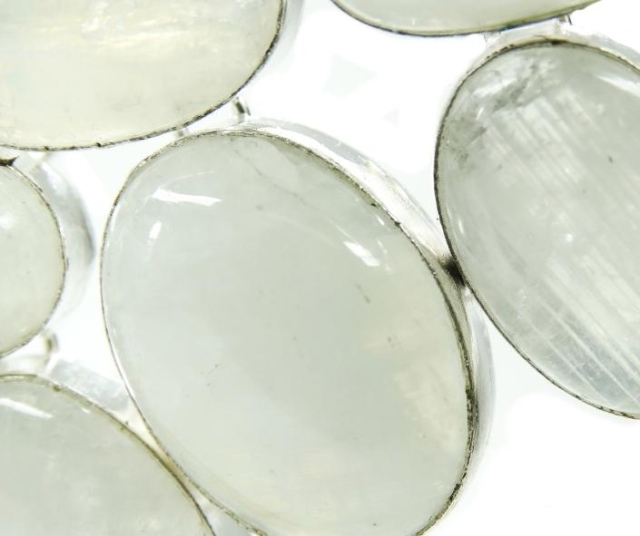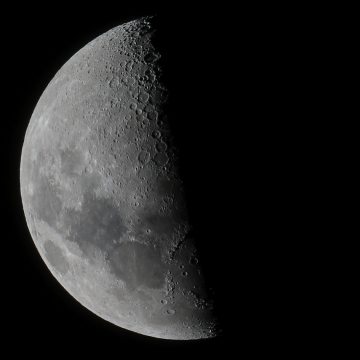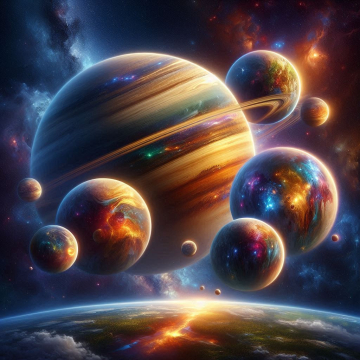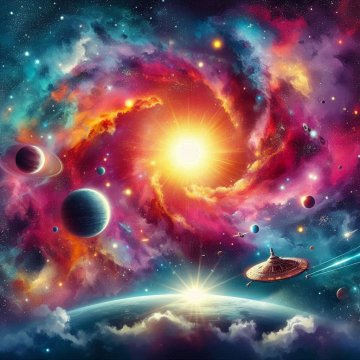Moonstones , with their mysterious and ethereal beauty, have captivated humanity for centuries. With their soft shine and brilliant play of colors, these gems have been revered in various cultures and times as bearers of cosmic and spiritual powers.
Geological Origin of Moonstones
Moonstones, despite their name, are not related to the moon in any cosmic way. Its name comes from its ethereal appearance, which often resembles moonlight. These gems are a variety of feldspar, a common mineral found in the Earth's crust. The unique beauty of moonstones is due to the way light interacts with the internal structure of these minerals.
Moonstones belong to the potassium feldspar family, which includes minerals such as orthoclase and albite. What makes moonstones special is the presence of microscopic inclusions of minerals such as albite or orthoclass, which create an optical effect called "adularescence." This adularescence is what gives moonstones their characteristic bluish glow and their ability to display a play of colors when rotated under light.
The Color Game of Moonstones
The play of color, also known as adularescence, is one of the most distinctive characteristics of moonstones. This optical effect manifests itself as a bluish or iridescent glow that moves across the gem as it is moved. The intensity and colors of the color play can vary, and in high quality moonstones, they can display a wide range of colors, from blues and greens to oranges and pinks. The play of colors is due to the interference of light on the layers of feldspar with microscopic inclusions, creating a fascinating visual effect that has intrigued humanity for centuries.
History and Myths of Moonstones
Moonstones have a long history of mysticism and spiritual significance in many cultures. Throughout history, a variety of powers and meanings have been attributed to these gems. Some of the more interesting beliefs and myths related to moonstones include:
Hindu Mythology : In Hindu mythology, moonstones were considered stones of power and protection, associated with the gods. Moonstones were believed to have the ability to bring peace and harmony to the wearer.
Roman Mythology : In ancient Rome, moonstones were associated with the moon goddess, Diana. It was believed that wearing a moonstone could bring love and prosperity to a person's life.
Greek Mythology : In ancient Greece, moonstones were believed to be frozen tears of the gods. This belief contributed to the idea that moonstones had protective and healing properties.
Arab Cultures : Arab cultures believed that moonstones were "health stones" and used them to alleviate illnesses and vision problems.
Modern Beliefs: Even today, many people believe in the spiritual power of moonstones and use them to increase intuition, encourage creativity, and balance emotions.
The Role of Moonstones in Jewelry
Moonstones have been valued in jewelry for centuries due to their beauty and mysticism. They are commonly used in the making of rings, earrings, necklaces and bracelets. The softness of their shine and their unique play of colors make them especially popular in women's jewelry. In addition to their use in jewelry, moonstones are often incorporated into art and decorative pieces due to their uniqueness and appeal.
Types of Moonstones
Not all moonstones are the same. There are several different types of moonstones, each with their own unique characteristics. Some of the more well-known types include:
Adularescent Moonstone: This is the most common type of moonstone and is known for its play of blue and white colors.
Rainbow Moonstone : These moonstones have a color set that includes a variety of colors, such as blue, green, orange, and pink.
Cat's Eye Moonstone : These moonstones have a stripe of light that resembles a cat's eye when viewed from certain angles.
Peach Moonstone : These moonstones have a warm-toned base color, such as pink or peach, and can display a play of color similar to more traditional varieties.
Metaphysical Uses of Moonstones
Today, moonstones continue to be prized for their metaphysical properties. These gems are believed to have a number of spiritual and therapeutic benefits, such as:
Emotional Balance: It is believed that moonstones can help balance emotions and promote inner peace.
Intuition: Some people use moonstones to increase intuition and clairvoyance.
Fertility : In some cultures, moonstones are associated with fertility and are used as amulets to promote conception and a healthy pregnancy.
Protection : Moonstones are believed to have protective properties and can ward off negative energies.
Creativity : It is said that these gems can stimulate creativity and inspiration.
Care and Maintenance of Moonstones
Moonstones are relatively fragile compared to other precious gems, so they require special care to maintain their beauty and durability. Some moonstone care tips include:
Avoid bumps: Due to their delicate structure, moonstones are susceptible to bumps and scratches. They must be handled with care and protected from impacts.
Gentle Cleaning: Clean the moonstones with a soft, damp cloth instead of soaking them in water or other cleaning products.
Avoid Exposure to Chemicals: Avoid exposing moonstones to harsh chemicals, such as cleaning products and perfumes, which can damage their surface.
Proper Storage: Store your moonstone jewelry in a safe place, away from other jewelry that may scratch or damage it.
Despite the belief in their spiritual power, moonstones are also prized for their beauty today. They are a popular choice in the jewelry industry and are used in a wide range of designs, from minimalist pieces to more elaborate jewelry. Their versatility and unique color play make them suitable for a variety of styles and occasions.






